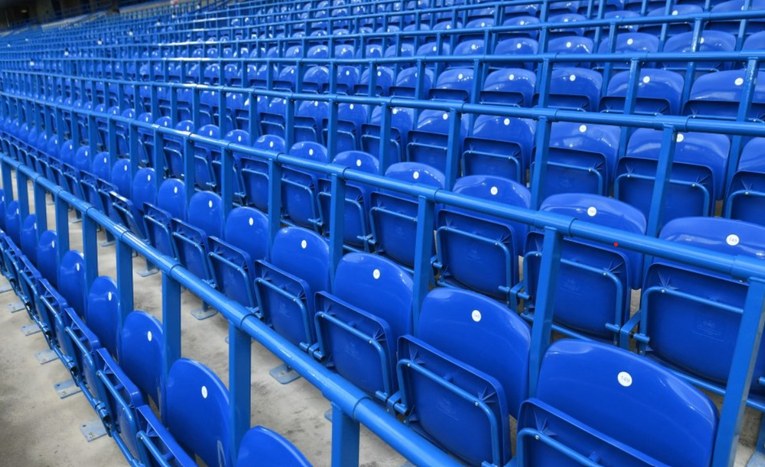
Numerous things happened in the wake of the Hillsborough Stadium Disaster that maybe shouldn’t have.
We now know that the deaths of 97 people were due to police negligence, made worse by the fact that Hillsborough Stadium was not fit for purpose and didn’t have an up-to-date safety certificate.
Yet the smear campaign against supporters, which lasted for more than 30 years, had countless impacts on the sport in general. One of them was the result of the Taylor Report, which forced all top-level stadiums in the United Kingdom to become all-seater.
In recent years, safe standing has begun to be introduced, but is it working?
What is ‘Safe Standing’?
The first place to start is by looking into what, exactly, ‘safe standing’ is.
Anyone who has ever been to a football ground will almost certainly have experienced ‘unsafe standing’. Supporters in certain areas of grounds, where everyone stands for the duration of the match, can end up several rows away from where their ticket is based and not even on their feet on occasions when an important goal is scored.
The likes of the Kop at Anfield, the home of Liverpool Football Club, sees supporters stand for the entire 90-plus minutes of a game, with fans ending up getting hurt in the wake of big goals that the ground has seen plenty of.
Flag day on Sunday for Spurs. Let’s celebrate the Kop in the best possible way. 30 years on since the Kops last stand. Let’s keep our traditions alive 🔴🚩⚪️ pic.twitter.com/Xr6vjUzr5S
— Spion Kop 1906 (@SpionKop1906) May 3, 2024
The entire purpose of safe standing is to allow people to stand up during events like football matches, but without being in danger of falling over the seat in front of them or of becoming in danger from a crush.
There are numerous different forms of safe standing, but the Green Guide, which is the guideline for sports ground safety in the United Kingdom, sets out of the parameters as being crucial to the introduction of it in the country.
Most grounds that have safe standing use so-called rail seating, which sees each seat incorporated into a metal frame, which then offers a waist-high rail in front of the supporter within the same space as a conventional seat.
When it was Introduced in the United Kingdom
The use of safe standing has been in place in Germany for many years, with the likes of Borussia Dortmund being famous thanks to the impressive sight of the ‘Yellow Wall’.
In the United Kingdom, meanwhile, it didn’t come about until the July of 2016, which was when Celtic unveiled an area with a capacity of 2,600 rail seating. They were the first British club to bring it in, having obtained a ‘safe standing’ certificate from Glasgow City Council 13 months before.
Other clubs slowly began to follow suit, with Cardiff City, Chelsea, Manchester City, Manchester United and Tottenham Hotspur all doing so as part of a trial in 2021.
The British government then confirmed that any clubs in the Premier League and Championship that wished to introduce safe standing areas would be allowed to do so from the 2022-2023 season onwards. Brentford, Queens Park Rangers and Wolverhampton Wanderers immediately added their names to the list, with Liverpool also looking to do so after consultation with the supporters.
After completing a trial, the club put forward an application to have a Safe Standing Licence for the Kop, as well as for parts of the Anfield Road end of the ground, which is where the away supporter allocation is located within the stadium.
What’s the Verdict….Has it Worked?
With safe standing now having been in place at grounds around the UK for a number of years, it is fair to ask whether or not it has actually worked.
The site Safe Standing United group keeps tracks of which clubs have introduced it, with their aim being to persuade Sheffield United to introduce it at Bramall Lane.
The sense is that it has been a success at the other grounds that have brought it in, which is why so many of the club’s supporter groups are behind it.
When the trial was introduced in 2022, fans of clubs that did bring it in were asked their take on its usage. The overall feeling was that it had seen an improvement in the atmosphere.
@matchdayvlogs Safe Standing in the process of being installed.. #sfc #SaintsFC #Southampton #safestanding
One supporter of Tottenham Hotspur, who had introduced it at the club’s South Stand, said, “When there’s a goal and you’re standing it’s brilliant because everyone joins in. It’s like a family thing. Everyone’s full of life and loving it”. Even Margaret Aspinall, the mother of James who died at Hillsborough when he was 18, said that her opinion on standing in general had ‘completely changed‘ as a result of safe standing.
With no major incidents in areas with safe standing and a reported improvement in atmosphere, there can be little question that safe standing as a concept as worked.
The hope is that it will continue to do so in the long-term.
